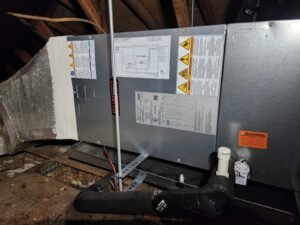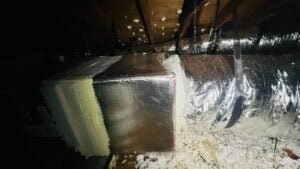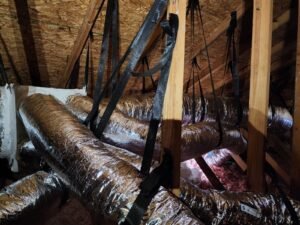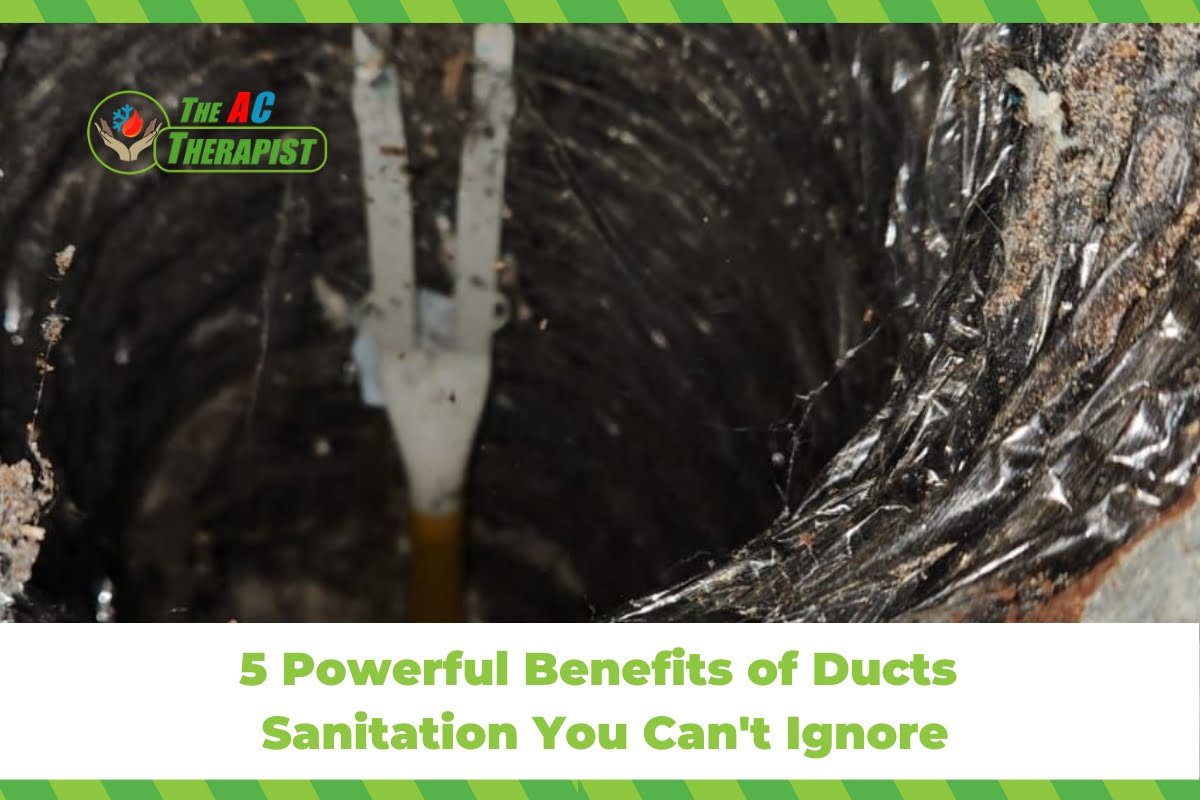5 Powerful Benefits of Ducts Sanitation You Can’t Ignore
Duct sanitation refers to the process of cleaning and disinfecting the ductwork in an HVAC (Heating, Ventilation, and Air Conditioning) system. This process involves more than just removing dust and debris; it also includes using sanitizing agents to kill bacteria, mold, and other microorganisms that may be lurking in the ducts. This comprehensive cleaning helps to ensure that the air circulating through your HVAC system is as clean as possible, which is crucial for maintaining good indoor air quality.
The steps for duct sanitation typically include:
- Inspection: A thorough examination of the ductwork is carried out to identify areas with significant dust accumulation or microbial growth.
- Cleaning: Specialized tools like brushes, air whips, and vacuum equipment are used to dislodge and remove dust, debris, and other contaminants from the ductwork.
- Sanitization: After cleaning, the ducts are treated with sanitizing agents, such as antimicrobial solutions, to kill bacteria, mold, and other microbes.
- Sealing and Repair: Any leaks or small holes in the ductwork may be sealed to improve system efficiency and prevent future contamination.
- Final Inspection: Post-cleaning, another inspection is usually conducted to ensure that the ducts are clean and the sanitation process is effective.
Duct sanitation is particularly beneficial for:
- Improved Air Quality: Cleaning and sanitizing the ducts can remove contaminants that circulate throughout a building, thereby improving indoor air quality. This is especially crucial for individuals with allergies, asthma, or other respiratory issues.
- Energy Efficiency: Clean ducts allow air to flow more efficiently, reducing the amount of work your HVAC system has to do to heat or cool your space. This can lower your energy bills and prolong the lifespan of your HVAC system.
- Odor Elimination: Dust, mold, and bacteria can produce unpleasant odors. Sanitizing your ducts can help to eliminate these smells, making your indoor environment more pleasant.
- Health Benefits: By removing potential pathogens and allergens from your ducts, you are less likely to suffer from health problems related to poor air quality, such as respiratory issues or skin irritations.
- Compliance: In some jurisdictions and industries, regular duct cleaning and sanitation may be required to meet health and safety standards.
Regular duct sanitation is often recommended as part of a comprehensive HVAC maintenance plan to keep your system running efficiently and your indoor environment healthy.

Why is it necessary?
Duct sanitation in HVAC systems can provide several health benefits, which might be of interest to you as The AC Therapist. Here are some of the key advantages:
- Improved Indoor Air Quality (IAQ): Duct sanitation helps remove dust, debris, mold, and other contaminants from the ductwork. This, in turn, leads to cleaner and healthier indoor air for your clients. Cleaner air can reduce allergy symptoms and improve overall respiratory health.
- Reduced Allergens and Irritants: Cleaning and sanitizing the ducts can significantly reduce the presence of allergens such as pollen, pet dander, and dust mites. This can be particularly beneficial for individuals with allergies or asthma, promoting a more comfortable and healthy indoor environment.
- Preventing Mold Growth: Mold growth in HVAC ducts can be a serious health concern. Duct sanitation helps eliminate existing mold and prevents its recurrence. Mold spores in the air can trigger respiratory problems and allergies, so removing them is essential for health.
- Odor Removal: Duct sanitation can help eliminate unpleasant odors that may be circulating through the HVAC system. This is especially useful in homes or commercial spaces where odors from cooking, pets, or other sources are a concern.
- Reduced Transmission of Illness: Clean and sanitized ducts can help reduce the spread of airborne illnesses and contaminants within a building. This is particularly important in commercial spaces where multiple people may be present, as it can contribute to a healthier working environment.
- Energy Efficiency: Clean ducts can improve the efficiency of the HVAC system. When ducts are clogged with dust and debris, the system has to work harder to maintain the desired temperature, which can lead to higher energy consumption and costs.
- Extended HVAC Lifespan: Regular duct sanitation can also help extend the lifespan of HVAC equipment. By reducing the strain on the system and preventing the buildup of harmful substances, you can avoid costly repairs or replacements.
How often should ducts be sanitized?
The frequency of duct sanitation can vary depending on several factors, including the specific needs of the HVAC system and the indoor environment. There isn’t a one-size-fits-all answer, but here are some guidelines to consider:
- Regular Inspection: It’s a good practice to have your ductwork inspected regularly, typically once a year. During these inspections, HVAC professionals can assess the condition of the ducts and determine if sanitation is necessary.
- Environmental Factors: Homes or buildings in particularly dusty or humid environments may require more frequent duct sanitation. Factors like nearby construction, pet dander, or high pollen levels can also influence the need for more frequent cleaning.
- Health Concerns: If residents in the home have allergies, asthma, or other respiratory conditions, more frequent duct sanitation may be advisable to maintain good indoor air quality and reduce potential allergen exposure.
- Previous Contamination: If your ducts have had a history of microbial contamination (e.g., mold or mildew growth), it’s important to address the issue promptly and schedule regular follow-up sanitations to prevent recurrence.
- New Construction or Renovations: Ducts in newly constructed homes or those that have undergone significant renovations may accumulate construction dust and debris. It’s a good idea to schedule duct sanitation after such events.
- HVAC System Age: Older HVAC systems may require more frequent duct sanitation as they are more prone to issues like dust buildup and wear and tear.
- Use of High-Efficiency Filters: If you use high-efficiency filters that capture smaller particles, you may be able to extend the time between duct sanitation.
Ultimately, the decision on how often to sanitize ducts should be made on a case-by-case basis, taking into account the specific conditions and needs of the HVAC system and the building. It’s a good practice to work with a qualified HVAC professional who can assess your situation and recommend an appropriate schedule for duct sanitation.

What are the signs that my ducts need cleaning and sanitation?
Several signs can indicate that your ducts may be in need of cleaning and sanitation. If you notice any of the following issues or symptoms in your home or building, it’s a good idea to consider scheduling duct maintenance:
- Visible Dust and Debris: If you can see dust and debris accumulating around the supply and return vents or on the registers, this may be a sign that your ducts are collecting contaminants.
- Visible Mold or Mildew: The presence of mold or mildew in or around the ductwork is a clear indicator that duct cleaning and sanitation are necessary. Mold can pose health risks and should be addressed promptly.
- Unexplained Allergy Symptoms: If occupants of the building experience unexplained allergy symptoms like sneezing, coughing, or itchy eyes, it could be due to allergens circulating through the HVAC system. This is especially relevant if symptoms improve when away from the building.
- Musty or Unpleasant Odors: Foul or musty odors coming from the HVAC system when it’s running can be a sign of mold or bacterial growth within the ducts. Odors may also indicate the presence of pet dander or other contaminants.
- Inconsistent Heating or Cooling: Uneven heating or cooling throughout the building can be a sign of restricted airflow caused by debris buildup in the ducts.
- Increased Energy Bills: A sudden or unexplained increase in energy bills could be due to reduced HVAC system efficiency caused by clogged ducts. When ducts are dirty, the system has to work harder to maintain temperature, leading to higher energy consumption.
- Excessive Dusting: If you find yourself dusting and cleaning surfaces more frequently than usual, it could be because dust and particles are being blown into the living spaces from the ducts.
- Visible Pest Infestations: If you notice evidence of pest infestations (e.g., droppings, nests) in or around ductwork, it’s essential to address the issue promptly and consider duct cleaning.
- Visible Debris During Filter Changes: When changing HVAC filters, if you notice a significant buildup of dust and debris on the filter, it’s an indication that contaminants are entering the ducts.
- Recent Construction or Renovation: After construction or renovation work in your home or building, ducts can become contaminated with construction dust and debris, making cleaning and sanitation necessary.
Are there any maintenance tips to keep my ducts clean after sanitation?
Absolutely, there are several maintenance tips that homeowners can follow to help keep their ducts clean and maintain the benefits of duct sanitation. Here are some helpful suggestions:
- Change HVAC Filters Regularly: One of the most critical steps in maintaining clean ducts is to change or clean the HVAC filters on a regular basis. This prevents dust and debris from entering the ducts in the first place and keeps the air flowing smoothly. Follow the manufacturer’s recommendations for filter replacement intervals.
- Seal Duct Leaks: Inspect your ductwork for any leaks or gaps. Sealing these leaks with mastic or foil tape can prevent the entry of contaminants and help maintain efficient airflow.
- Regular HVAC Maintenance: Schedule regular HVAC system maintenance with a professional. They can inspect the entire system, including the ducts, to ensure everything is in good working order. Regular maintenance can catch issues early before they lead to duct contamination.
- Keep the Area Around Vents Clean: Make sure the areas around vents and registers are kept clean and free from dust and debris. Vacuum and dust these areas regularly to prevent contaminants from being pulled into the ducts.
- Control Moisture: Moisture can lead to mold and mildew growth in ducts. Ensure that your home’s humidity levels are within a healthy range, and address any water leaks or condensation issues promptly.
- Use High-Quality Air Filters: Consider using high-efficiency air filters that can capture smaller particles and allergens. HEPA filters, for example, can be very effective in improving indoor air quality.
- Keep Ducts Sealed: Ensure that all access panels or doors to your ductwork are tightly sealed. This prevents contaminants from entering and keeps conditioned air from escaping.
- Regular Cleaning and Vacuuming: Regularly clean and vacuum your home to reduce the amount of dust and debris that can enter the HVAC system. This can significantly reduce the load on your ducts.
- Consider an Air Purifier: Installing an air purifier as part of your HVAC system can help remove contaminants from the air, reducing the workload on your ducts and filters.
- Professional Inspections: Periodically schedule professional inspections of your ductwork to ensure there are no issues or contamination buildup that need addressing.
By following these maintenance tips, homeowners can help ensure that their ducts remain clean and the benefits of duct sanitation are preserved. Regular upkeep and attention to indoor air quality can contribute to a healthier and more efficient HVAC system.

Do you use any specific products or methods for duct sanitation?
Products:
- Antimicrobial Treatments: Antimicrobial agents are often used to kill and inhibit the growth of mold, mildew, bacteria, and other microorganisms within the ductwork. These treatments can help ensure a sanitized environment.
- Biocides: Biocides are chemical agents designed to eliminate microbial contaminants within the ducts. They are effective at targeting and destroying mold, bacteria, and other unwanted organisms.
- Duct Sealants: Duct sealants are used to seal leaks and gaps in ductwork. While primarily used for sealing rather than sanitation, they can help prevent contaminants from entering the system.
- HEPA Filters: High-efficiency particulate Air (HEPA) filters can be installed in the HVAC system to capture small particles, including allergens and microbial spores, improving indoor air quality.
- UV Germicidal Lights: Ultraviolet (UV) germicidal lights are designed to kill or sterilize microorganisms that pass by them. When installed in the ductwork, they can help control microbial growth.
Methods:
- Mechanical Cleaning: Mechanical cleaning involves physically removing dust, dirt, and debris from the ducts. This can be done using specialized brushes, vacuums, and air whip systems.
- Negative Air Pressure: Negative air pressure systems use powerful vacuums to create suction within the ducts, dislodging and removing contaminants. This method is effective for removing loose debris.
- Air Duct Sanitization: After mechanical cleaning, an antimicrobial treatment or biocide may be applied to the ductwork to eliminate any remaining microorganisms.
- UV-C Light Treatment: UV-C lights can be installed within the ducts to continuously irradiate and kill microbes as air passes through. This method is particularly effective for preventing microbial growth.
- Fogging: Fogging involves the introduction of a fine mist of antimicrobial solution into the ducts. This mist settles on surfaces, eliminating contaminants.
What is the difference between duct cleaning and duct sanitation?
Duct cleaning and duct sanitation are related services for maintaining HVAC systems, but they serve slightly different purposes:
Duct Cleaning:
Duct cleaning primarily focuses on the removal of dust, debris, and contaminants that have accumulated within the HVAC ductwork over time. This process involves a thorough cleaning of the entire duct system, including the supply and return ducts, as well as the various components like vents and registers. Here are some key points about duct cleaning:
- Dust and Debris Removal: Duct cleaning aims to eliminate dust, dirt, pet dander, pollen, and other airborne particles that can accumulate in the ducts.
- Improved Airflow: Cleaning the ducts can improve the airflow in the HVAC system, allowing it to operate more efficiently.
- Allergen Reduction: Duct cleaning can help reduce allergens in the indoor air, potentially providing relief to individuals with allergies or respiratory issues.
Duct Sanitation:
Duct sanitation, on the other hand, primarily focuses on disinfecting and sterilizing the interior of the ductwork. It aims to eliminate microorganisms, such as bacteria, viruses, mold, and mildew, which can thrive in the dark and damp environment of ducts. Here are some key points about duct sanitation:
- Microbial Elimination: Duct sanitation is specifically designed to target and eliminate microorganisms that can cause health problems and odors in the duct system.
- Improved Indoor Air Quality: By removing harmful microbes, duct sanitation contributes to better indoor air quality and a healthier living or working environment.
- Odor Control: It helps in controlling and eliminating unpleasant odors that may be associated with microbial growth in the ducts.
In summary, duct cleaning is primarily concerned with the physical removal of dust and debris, while duct sanitation focuses on disinfecting and eliminating microorganisms. Often, HVAC contractors may offer both services as part of a comprehensive duct maintenance plan to ensure that the ductwork is clean and free from contaminants, promoting both efficient operation and healthier indoor air quality.

Breathe Easy with The AC Therapist: Ensuring Health and Comfort through Duct Sanitation
In conclusion, the importance of duct sanitation in maintaining a healthy and efficient HVAC system cannot be overstated. As we’ve explored in this blog, clean and sanitized ducts offer a range of benefits, from improved indoor air quality to energy efficiency and the prevention of health issues. Whether you’re a homeowner looking to enhance the comfort and well-being of your family or a business owner striving to create a healthier workspace, investing in duct sanitation is a proactive step toward achieving those goals.
At The AC Therapist, your local residential and light commercial HVAC contractor in the Tampa Bay area, we understand the significance of clean ductwork for your indoor environment. Our dedicated team is here to provide top-notch services, including duct sanitation, to ensure that your HVAC system operates at its best. With our Therapy Maintenance Plans, you can enjoy the peace of mind that comes with regular maintenance, including duct sanitation, to keep your system in optimal condition.
Don’t hesitate to reach out to The AC Therapist for all your HVAC needs, whether it’s duct cleaning, sanitation, or any other air conditioning service. Your comfort, health, and satisfaction are our priorities, and we’re here to serve you. Breathe easy and enjoy a more efficient HVAC system with the expertise of The AC Therapist by your side.









